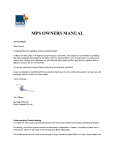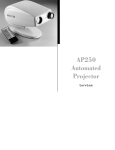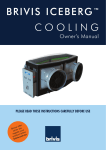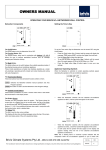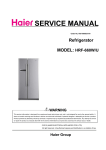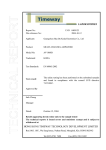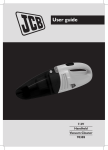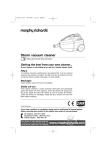Download Classic Owners Manual
Transcript
Classic Owners Manual To the Owner. Dear Owner, Congratulations on selecting a Brivis Heating System. At Brivis we take pride in all aspects of servicing our customers. Our people are committed to upholding the ethics originally formulated by my father when he founded Brivis over 40 years ago. Our aims are to ensure your comfort and satisfaction by providing the best quality product and service, together with a genuine concern for our environment. To all new customers buying a Brivis product for the first time, welcome! If you are already an established Brivis customer, thank you for your continued support. I am sure you will be happy with the choice you have made. Yours sincerely, Tim O'Brien Managing Director Brivis Australia Pty Ltd Understanding Central Heating. To make the most of your central heating, you first need to be familiar with its basic operating principles. Put simply, your Brivis system consists of three major components; a heater, a ductwork system and a wall control. The heater draws air out of the house through a large, centrally located Return Air duct. Once heated, the air is then re-distributed to every corner of the house via a network of smaller ducts, and released into each room through floor or ceiling outlets. The entire process is directed by a wall-mounted control which is usually positioned in the living area on an internal wall and away from windows and doors if possible. For best performance, the following points should be borne in mind: * Ensure that your home is well insulated. Wall-to-wall floor coverings, drapes, pelmets and even wall insulation, can all help reduce your energy consumption. * Turn the heating OFF at night and back on again when you wake in the morning. * Keep the temperature setting low if you are active in the house. The normal operating o o temperature in most average homes should be around 17 C to 21 C. * Don't leave external doors and windows open. * Fumes from candles, fragrant oil burners, cooking or smoking may be drawn into the system, (especially if the Return Air inlet is in the ceiling) and can cause staining around the heating outlets. Installing an Electronic Air Filter in the Return Air will help avoid this problem. Just follow these few guidelines and your Brivis Central Heating System is sure to provide you with many years of warmth and satisfaction. Heater Operation. Preparing for Start Up. * Ensure your wall control is set at the OFF position. * Go to the Heater and turn ON the gas cock on the gas supply adjacent to the unit. * Turn ON the 240 V power supply at the power point, ensuring the plug is firmly located in the socket. * Remove the front cover and follow the Lighting Instructions printed on the inside of that cover. Then replace the cover. * If the unit has been shutdown for an extended period of time or after any interruption to the gas supply, it may take several attempts to start the heater, as air may need to be purged from the gas pipe. The heater may now be operated from the Wall Control. * When the Wall Control calls for heat, gas flows to the main burners and ignition from the pilot is established. The systems will allow approximately one minute for the burners time to generate heat before it starts the fan. This process ensures that the air delivered into the house is warm. * With an external heater, it is not abnormal to see vapour discharging from the flue terminal, when the unit is operating. Power supply interruption. The heater will not operate without a 240 Volt power supply to the unit. If the power supply is interrupted during the heater's operation, the unit has safety mechanisms to turn off the gas supply. When the power is restored, the heater will resume normal operation automatically. Outlet Guide. For all systems, a minimum number of outlets must remain fully open (this includes both the outlet grille and the damper in the duct), if the heater is to operate properly without overheating. Similarly, ceiling systems have a minimum number of outlets that can remain fully open, to ensure that the velocity through each outlet is sufficient. The maximum number relates to fully open outlets, however, the system will operate effectively with more outlets open, if it has been properly balanced. There is no maximum number for floor outlets, so the chart below lists the usual number of floor outlets for each heater. External Heaters Minimum Ceiling Floor Buffalo 52 3 5 7 Buffalo 85 5 8 12 Buffalo 85 XA 5 10 12 Buffalo 120 8 11 16 Buffalo 120 XA 8 13 16 Wombat 52 3 5 7 Wombat 92 6 8 13 Wombat 92 XA 6 10 13 Wombat 120 8 11 16 Wombat 120 XA 8 13 16 Upflow 92 6 8 13 Upflow 120 8 12 16 Downflow 92 6 7 13 Manual Wall Control. If your Brivis Central Heating System has a manual Wall Control you can turn it ON by sliding the lever at the base across to the required Set Temperature, and turn OFF by sliding the lever to the extreme left until it clicks. The current room temperature is indicated by the gauge in the top window. If the current room temperature is lower than the Set Temperature, the heater will operate to reach and maintain the Set Temperature. Of course, if the current room temperature is higher than the Set Temperature, the heater will not switch ON until it falls below that Set Temperature. Electronic Wall Controller. At first glance, an electronic wall control can look complicated, but it really is very simple. It can be as basic or as sophisticated as you need or want it to be. These instructions are designed to allow you to choose just how far you want to go. We start by setting the current time. Then, with just two steps we can have the heating system operating. STEP 1. "How do I set the clock?" Setting the time involves 4 keys: - Start by pressing SET PRESENT DAY/TIME. Now use the DAY key to display the current day. Then use the TIME keys (AHEAD/BACK) to set the correct time. To save your changes, press RUN PROGRAM. STEP 2. "How do I get instant heat?" Move the switch marked HEAT OFF COOL to "Heat" and make sure the FAN switch is in "Auto". Normally, the display shows the current room temperature. The system however, works to maintain a Set Temperature and pressing the PRESENT SETTING key will display that Set Temperature. If the current room temperature is lower than the Set Temperature, the heater will operate to reach and maintain the Set Temperature. Of course, if the current room temperature is higher than the Set Temperature, the heater will not switch on until it falls below that Set Temperature. To change the Set Temperature: First, press the HOLD TEMP key to ensure that your new setting will be held for as long as you want. Then, just use the TEMPERATURE keys, (WARMER/COOLER), to raise and lower that Set Temperature. At this point you have enough information to use the electronic wall controller to operate the heating system manually. But, if you wish, it can do much more. Automatic Operation. In automatic mode the electronic wall controller has a auto-program that has been pre-set to turn the system ON in the morning, and OFF when you go to sleep at night. o Wake 6:00am 21 C. Leave - - - Return - - - Sleep 10:00pm - However, as you can see, the system does allow for a total of four periods. The WAKE setting is usually used to start the system and pre-warm the house before everyone gets up, and the LEAVE setting can turn it OFF when the family has left for the day. RETURN is then used to switch the system back ON again just before everyone gets home, and SLEEP can turn it OFF after they are all asleep. It is recommended that the system be set to turn OFF overnight [as displayed by the (- -) symbol] to save energy and lower your gas bill. If the pre-set times and temperatures do not suit your lifestyle they can easily be changed. All you have to do is tell it what you would like it to do. Note: The Classic electronic wall controller is powered by 3 alkaline batteries. When the REPL BAT message appears on the screen, remove the Controller from its base by lossening the screws at the bottom corners and replace the batteries. STEP 1. Select the Period you wish to Change. There are separate keys for WAKE, LEAVE, RETURN and SLEEP. Just press the key for the period you want to change. Once you have selected the period you want, move to Step 2 if you want change the Time, or Step 3 if you want to change the Temperature. STEP 2. Changing the Time of a Period. After selecting the Period to be changed then ... - Press the DAY key to select the day. Note: In programming, the DAY key gives you all the weekdays in one block. This is designed to avoid having to program every weekday individually. - Now use the TIME keys (AHEAD/BACK) to set the time you want the system to come ON, making sure you allow time for it to reach the Set Temperature. - To save your changes, press RUN PROGRAM. STEP 3. Changing the Temperature of a Period. Again, select the Period to be changed then ... - Press the DAY key to select the day. - Now use the TEMPERATURE keys (WARMER/ COOLER), to raise and lower the Set Temperature. - To save your changes, press RUN PROGRAM. Once you have completed this process for Saturday, Sunday and the weekdays, you have programmed your heating system. STEP 4. Overriding the Program. If you want to interrupt the program for any reason you can. The simplest method is to use the TEMPERATURE keys (WARMER/ COOLER) and just select the temperature you want. But, there are also three other options. If all the periods have been programmed, then the SKIP NEXT PERIOD key allows you to stay in the current settings and ignore the next period. So, if you're in the WAKE period and you decide to stay home all day, just press SKIP and the WAKE period will be maintained right through until the RETURN period begins. If the system has already started the LEAVE period and you decide not to go out, just press CHANGE TO LAST PERIOD and the system will go back to the WAKE period settings until RETURN begins. All of these changes are temporary because the automatic program will resume when it reaches the next program period. If you want to suspend the entire program for hours, days, weeks, or whatever, simply press HOLD TEMP, then use the TEMPERATURE keys to set the required temperature. The system will then hold that temperature for as long as you want. Once the circumstances return to normal, you can cancel any of these changes and return to the program by pressing RUN PROGRAM. STEP 5. Fan Only Operation. In AUTO mode the fan is controlled by the heater but you can have the fan connected so it will run continuously when the Fan selection switch is turned ON. (The HEAT OFF COOL button needs to be in the OFF position) This facility can be added to any Brivis heater. Just ask your installer to make the connection when installing the system. Heater Maintenance. The frequency of cleaning will depend on local conditions, so an inspection should be performed regularly. * Check that the power lead and gas pipe are in good condition. If they are damaged, call Brivis for service. * If a RETURN AIR FILTER is fitted in the return air grille, it requires regular cleaning, and should be checked every fortnight. A blocked filter will seriously affect the heater's performance and economical operation. If you wish to close the heater down for summer or holidays, it is only necessary to turn off the external gas cock and switch off the power to the heater. Cautions: * Do not place articles on or against your heater. * Do not use, or store, flammable materials near the heater. * Do not spray aerosols in the vicinity of the heater while it is in operation. * The front cover of the heater must be on when the unit is in operation. * Do not hose the flue terminal on external heaters. * Ensure that the flue terminals on external heaters is kept clear of plant growth or any other obstructions Ductwork Maintenance. Under normal conditions, ductwork should not require cleaning or maintenance. An inspection every 5 years will ensure that it is still in good order. This inspection can be carried out by the home owner or by a Brivis service technician. Heater Service To ensure that your Brivis Heater continues to operate at peak efficiency, it is recommended that it be periodically serviced by a qualified Brivis technician. For example, the burners should be removed and cleaned every two to three years, the fan blades should be checked every four to six years and the cabinet and heat exchanger panels should also be inspected and cleaned as required.










